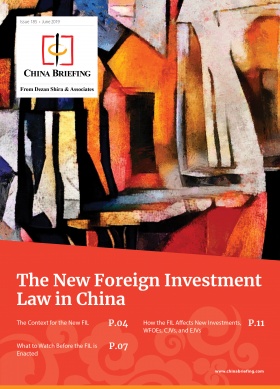COVID-19’s Grim Milestones: Impact on Business is Real but Opens Up New Growth Areas
Op-ed by Riccardo Benussi, Dezan Shira & Associates
In his book “La Peste” (The Plague), Albert Camus writes, “Pestilence is so common, there have been as many plagues in the world as there have been wars, yet plagues and wars always find people equally unprepared. When war breaks out people say: ‘It won’t last, it’s too stupid.’”
Yet looking at the now well-known Johns Hopkins dashboard online it seems that COVID-19 is here to stay longer and affect us deeper than what we were ready to accept. With an increase of almost 260,000 confirmed cases over the last weekend alone, and the global total crossing 938,000 confirmed cases worldwide, this was far from anybody’s initial expectation, making Camus’ sentence a most fitting observation. There is no hero here with a vaccine or any country that can save the day in Hollywood fashion. This is real. Much is being said about the losses, the drama, the social and institutional frictions in countries with little to no preparation and global media has barely spoken about little else these days.
While the inevitable global slowdown that has followed is unquestionably a time to contemplate and look back, we should also stay receptive to the notion that progress comes from dire situations and from thinking about a problem with ever changing perspectives – put it another way, crises necessitate creative solutions. And so we would be foolish not to look into opportunities in these unique times – mankind needs to push forward, especially when under such pressure. Inventiveness, adaptation, and maybe even the instinct to protect and preserve ourselves, these collectively force us to recognize new opportunities – whether to cater to the immediate economic aspects of companies’ and people’s livelihoods or to invest in the preparedness to deal with similar events in the future.
Regardless of one’s economic philosophy, the global reach of this virus should now more than ever encourage continuous collaboration between individuals, and between the public and private sectors.
On impact
As usual, doom and gloom overshadows the good news, and worldwide now, foreign and domestic small and medium enterprises (SMEs) and multinational companies (MNCs) are suffering and in some extreme cases even shutting down. Goods have been stranded at ports for weeks, hundreds of cities worldwide are in lockdown, civil and commercial transportation are experiencing cuts, delays, and cancellations like no other time. Consumers are behaving erratically, resorting to panic shopping, or revising their entire values of material versus immaterial needs. Legislators are trying to catch up with daily events to accommodate needs, and there’s pain and strain on global supply chains.
A very fair and local estimation* conveys that the general sentiment on businesses involved in sales and production is largely negative – both over the short- and medium-term.
(* 26 percent respondents (on average, China-based Chambers of Commerce) see decrease of 20 percent revenue in their business for 2020 and one third of respondents see inevitable reductions of yearly targets.)
On opportunities
However, several companies are not silently watching – they have adapted like chameleons to the situation and stretched their brand, reshuffled their production lines, and catered to new needs. In short, they have listened to the market and taken a risk or two, making COVID-19 the main propeller for new growth in some sectors and reviving dormant potential in others. Even the judiciary system in China is going online – filings and hearings are increasingly digitized, which could enhance the speed of executing work and get rid of some of the backlog. In the realm of productivity, we have seen a strong rise in cloud services for collaboration, solutions to minimize paperwork and physical contact, reimbursement apps and digital solutions for accounting, and the growth of contact-less devices for an infinite number of environments.
Going sector-wise, we are also seeing opportunities in the below:
- Food – fresh groceries and meat, cold storage, high quality foreign food and beverage, cooking appliances.
- Entertainment – gaming industry, new ways of disseminating content and promoting small businesses, online cooking classes, and virtual visits to landmarks.
- Education, sports, and well-being – virtual classrooms, online fitness classes.
- Services industry – contact-less systems, enhanced delivery services, remote banking services.
- Healthcare and health technology – pharmaceuticals, supplements, medical devices, personal protective equipment (PPE), telemedicine, smart hospitals and online consultations, digital medical assistants, apps and mini-apps, self-diagnosing medical devices.
- Electrical appliances – dishwashers and washing machines, sterilization machines, sweeping robots.
- Office cost reduction opportunities – office rent is expensive and flexible work arrangements are yet to be explored in their full functional scope. This will open up opportunities across multiple and linked sectors, such as office space redesign, building remote work systems, software platforms, and cloud-based services – all of which will likely see significant gains once the world economy goes into post-COVID-19 recovery mode and employers keep their office space costs in check in case their staff will need to work from other locations.
On FDI-related delayed projects in China
Due to cost cuts in headquarters, and limitations on civil and commercial movement, some FDI projects have been put on hold although this is more like a hand-break than a full stop. China remains the strongest destination for FDI because it is currently, and likely, the only country in Asia that can provide such an optimal and effective combination of supply, telecom infrastructure, human resources, logistics, and a large and ever changing demand base. Nonetheless, while some projects are on stand-by, a great deal of work can be done remotely.
International commerce has depended on Asia’s output for decades now. The irony is strong – Asia (China) now being able to resume production and satisfy pressing requirements from the rest of the world in Q1 is being met with a historical dip in demand across the majority of sectors it is used to cater to. Rarely in history has the supply chain had such fluctuations – while one part of the world was constantly pushing Chinese suppliers to make sure demand would be met by at least late Q1, now Chinese suppliers are struggling with extra stock because of countless cancelled orders and some industries cannot simply shut production down until demand resumes, causing factories to dispose of raw materials.
On relocating businesses in China
Among other challenges the virus has brought to the table are the need to relocate the actual production. As noted, the switch to another market completely may not be the most effective move for a China-based entity; rather, it should evaluate the advantages to perhaps relocate within China if the international route is not an option. At the same time, individuals who are stranded indefinitely in their home countries with family and don’t consider or cannot consider returning to China may now need to look back and consider a change of life and question themselves how to use one’s skills back at home?
On China’s new travel restrictions
Foreign-invested companies in China now also have to consider the additional weight of sudden travel restrictions introduced Thursday, from midnight, March 28, 2020, which bans the entry of most foreign travelers, thereby preventing many foreign-based executives from returning to the country. These restrictions, although temporary, may be in place for the foreseeable future as the country is working hard to avoid all possibility of a second wave of the outbreak. New quarantine policies have also been implemented, with varying degrees of consideration, across China’s provinces and cities – impacting inbound business travelers as well. We have discussed the latest policies, including the quarantine triggers and health code apps that have formed the basis of local containment strategies in this article – China’s Travel Restrictions due to COVID-19: An Explainer.
On disaster recovery and business continuity
If there is a single takeaway from the recent crises that have impacted businesses the world over, including in China, it is the importance of having a clear and well understood disaster recovery and business continuity (DRBC) strategy in place.
One would think that DRBC only comes in place when earthquakes or floods or nuclear plant disasters occur but the truth is that a virus like COVID-19 can be as disruptive and destructive as any natural disaster. Companies at all times need to have a sound DRBC plan in place which starts – as always – with awareness, then a dedicated team which is supported by SOPs and telecommunication (for example, cloud-based subscriptions) infrastructure to maintain the business information flow and provide access to corporate or factory information to all employees anywhere and at any time.
The businesses who can, and many do, emerge out of a crisis situation are those who plan for their worst-case scenarios, who simulate response strategies for all possible cases, ask difficult questions, identify key people to lead the firefight, and establish critical processes and financial solutions to implement them in real-time. Any sense of complacency, however, tends to get punished in the most unlikely circumstances, which is why being prepared is oftentimes the best line of defense. As Camus quite prophetically notes in The Plague, “That the plague bacillus never dies or vanishes entirely, that it can remain dormant for dozens of years, that it waits patiently in bedrooms, cellars, trunks, handkerchiefs, and old papers, and that perhaps the day will come when, for the instruction or misfortune, the plague will rouse its rats and send them to die in some well-contented city.”
The article is based on the author’s presentation and insights learned during the recent webinar held by the EU Chamber of Commerce General Members on “Reconfiguring Your China Business to Deal with HR, Financial, Supply Chain, Disaster Recovery, and Business Continuity After COVID-19”.
Related Reading
 China After COVID-19: How Foreign Companies Can Leverage Key IT Solutions
China After COVID-19: How Foreign Companies Can Leverage Key IT Solutions
 China’s Support Policies for Businesses Under COVID-19: A Comprehensive List
China’s Support Policies for Businesses Under COVID-19: A Comprehensive List
 China’s Social Credit System: COVID-19 Triggers Some Exemptions, Obligations for Businesses
China’s Social Credit System: COVID-19 Triggers Some Exemptions, Obligations for Businesses
About Us
China Briefing is written and produced by Dezan Shira & Associates. The practice assists foreign investors into China and has done so since 1992 through offices in Beijing, Tianjin, Dalian, Qingdao, Shanghai, Hangzhou, Ningbo, Suzhou, Guangzhou, Dongguan, Zhongshan, Shenzhen, and Hong Kong. Please contact the firm for assistance in China at china@dezshira.com.
We also maintain offices assisting foreign investors in Vietnam, Indonesia, Singapore, The Philippines, Malaysia, Thailand, United States, and Italy, in addition to our practices in India and Russia and our trade research facilities along the Belt & Road Initiative.
- Previous Article China Plus One Series: Cambodia’s Appeal to Foreign Investors
- Next Article China’s Annual Final Tax Settlement on Comprehensive Individual Income for AY 2019






